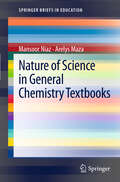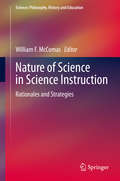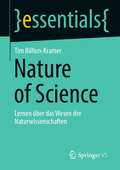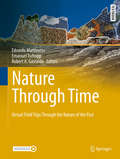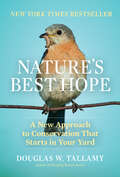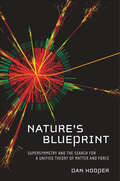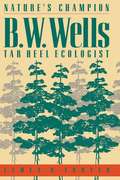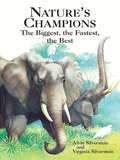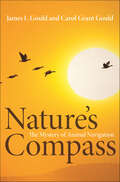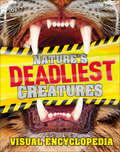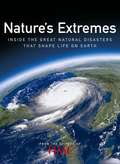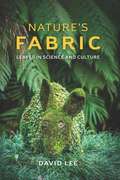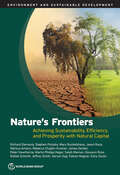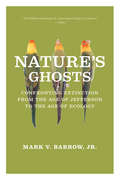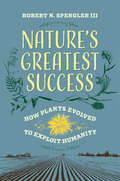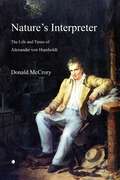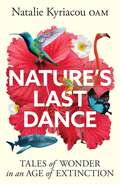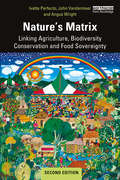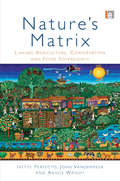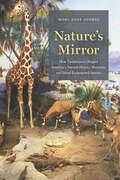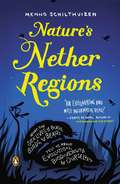- Table View
- List View
Nature of Science in General Chemistry Textbooks
by Arelys Maza Mansoor NiazResearch in science education has recognized the importance of history and philosophy of science (HPS). Nature of science (NOS) is considered to be an essential part of HPS with important implications for teaching science. The role played by textbooks in developing students' informed conceptions of NOS has been a source of considerable interest for science educators. In some parts of the world, textbooks become the curriculum and determine to a great extent what is taught and learned in the classroom. Given this background and interest, this monograph has evaluated NOS in university level general chemistry textbooks published in U.S.A. Most textbooks in this study provided little insight with respect to the nine criteria used for evaluating NOS. Some of the textbooks, however, inevitably refer to HPS and thus provide guidelines for future textbooks. A few of the textbooks go into considerable detail to present the atomic models of Dalton, Thomson, Rutherford, Bohr and wave mechanical to illustrate the tentative nature of scientific theories --- an important NOS aspect. These results lead to the question: Are we teaching science as practiced by scientists? An answer to this question can help us to understand the importance of NOS, by providing students an HPS-based environment, so that they too (just like the scientists) feel the thrill and excitement of discovering new things. This monograph provides students and teachers guidelines for introducing various aspects of NOS, based on historical episodes.
Nature of Science in Science Instruction: Rationales and Strategies (Science: Philosophy, History and Education)
by William F. McComasThis book offers a comprehensive introduction to Nature of Science (NOS), one of the most important aspects of science teaching and learning, and includes tested strategies for teaching aspects of the NOS in a variety of instructional settings. In line with the recommendations in the field to include NOS in all plans for science instruction, the book provides an accessible resource of background information on NOS, rationales for teaching these targeted NOS aspects, and – most importantly – how to teach about the nature of science in specific instructional contexts. The first section examines the why and what of NOS, its nature, and what research says about how to teach NOS in science settings. The second section focuses on extending knowledge about NOS to question of scientific method, theory-laden observation, the role of experiments and observations and distinctions between science, engineering and technology. The dominant theme of the remainder of the book is a focus on teaching aspects of NOS applicable to a wide variety of instructional environments.
Nature of Science: Lernen über das Wesen der Naturwissenschaften (essentials)
by Tim Billion-KramerIn naturwissenschaftlich und technisch geprägten Gesellschaften gilt ein angemessenes Wissenschaftsverständnis als wichtiger Teil von Allgemeinbildung und Scientific Literacy. Es wird in der Naturwissenschaftsdidaktik als Nature of Science (NOS) diskutiert und gelehrt. Dieses essential skizziert Nature of Science-Konzeptualisierungen mit ihren Stärken und Schwächen. Im Focus steht sowohl ein klassischer Minimalkonsens als auch alternative Ansätze. Außerdem werden zentrale Befunde empirischer Forschung und Bedingungen gelingenden Lernens zu Nature of Science dargestellt. Praxisideen sowie Hinweise zur vertiefenden Literatur runden dieses essential ab.
Nature through Time: Virtual field trips through the Nature of the past (Springer Textbooks in Earth Sciences, Geography and Environment)
by Edoardo Martinetto Emanuel Tschopp Robert A. GastaldoThis book simulates a historical walk through nature, teaching readers about the biodiversity on Earth in various eras with a focus on past terrestrial environments. Geared towards a student audience, using simple terms and avoiding long complex explanations, the book discusses the plants and animals that lived on land, the evolution of natural systems, and how these biological systems changed over time in geological and paleontological contexts. With easy-to-understand and scientifically accurate and up-to-date information, readers will be guided through major biological events from the Earth's past. The topics in the book represent a broad paleoenvironmental spectrum of interests and educational modules, allowing for virtual visits to rich geological times. Eras and events that are discussed include, but are not limited to, the much varied Quaternary environments, the evolution of plants and animals during the Cenozoic, the rise of angiosperms, vertebrate evolution and ecosystems in the Mesozoic, the Permian mass extinction, the late Paleozoic glaciation, and the origin of the first trees and land plants in the Devonian-Ordovician. With state-of-the art expert scientific instruction on these topics and up-to-date and scientifically accurate illustrations, this book can serve as an international course for students, teachers, and other interested individuals.
Nature's Best Hope: A New Approach to Conservation that Starts in Your Yard
by Douglas W. Tallamy&“Tallamy lays out all you need to know to participate in one of the great conservation projects of our time. Read it and get started!&” —Elizabeth Kolbert, Pulitzer Prize-winning author of The Sixth Extinction Douglas W. Tallamy&’s first book, Bringing Nature Home, awakened thousands of readers to an urgent situation: wildlife populations are in decline because the native plants they depend on are fast disappearing. His solution? Plant more natives. In this new book, Tallamy takes the next step and outlines his vision for a grassroots approach to conservation. Nature&’s Best Hope shows how homeowners everywhere can turn their yards into conservation corridors that provide wildlife habitats. Because this approach relies on the initiatives of private individuals, it is immune from the whims of government policy. Even more important, it&’s practical, effective, and easy—you will walk away with specific suggestions you can incorporate into your own yard. If you&’re concerned about doing something good for the environment, Nature&’s Best Hope is the blueprint you need. By acting now, you can help preserve our precious wildlife—and the planet—for future generations.
Nature's Blueprint: Supersymmetry and the Search for a Unified Theory of Matter and Force
by Dan HooperThe first accessible book on a theory of physics that explains the relationship between the particles and forces that make up our universe. For decades, physicists have been fascinated with the possibility that two seemingly independent aspects of our world—matter and force—may in fact be intimately connected and inseparable facets of nature. This idea, known as supersymmetry, is considered by many physicists to be one of the most beautiful and elegant theories ever conceived. According to this theory, however, there is much more to our universe than we have witnessed thus far. In particular, supersymmetry predicts that for each type of particle there must also exist others, called superpartners. To the frustration of many particle physicists, no such superpartner particles have ever been observed. As the world&’s most powerful particle accelerator—the Large Hadron Collider—begins operating in 2008, this may be about to change. By discovering the forms of matter predicted by supersymmetry, this incredible machine is set to transform our current understanding of the universe&’s laws and structure, and overturn the way that we think about matter, force, space, and time. Nature&’s Blueprint explores the reasons why supersymmetry is so integral to how we understand our world and describes the incredible machines used in the search for it. In an engaging and accessible style, it gives readers a glimpse into the symmetries, patterns, and very structure behind the universe and its laws. &“As the world&’s most powerful particle accelerator revs up, Dan Hooper&’s book is essential reading.&” —New Scientist &“[An] energetic exploration of modern physics.&” —Kirkus Reviews
Nature's Calendar: A Year in the Life of a Wildlife Sanctuary
by Colin ReesTake an enchanting journey through the shifting seasons in a wildlife sanctuary home to wetland, forest, and grassland and supporting an incredible diversity of plants and animals.Flocks of waterfowl exploding into steely skies above frozen marshland, salamanders creeping across the forest floor to vernal pools, chorusing frogs peeping their ecstasy while warblers crowd budding trees, turtles sunning on floating logs, the ecological engineering of beavers—these are but a few of the sights and sounds marking a year at Jug Bay Wetlands Sanctuary and its neighboring landscapes in Southern Maryland. In an absorbing account of a year in the life of this sanctuary, naturalist Colin Rees invites us to join him as he explores the secrets and wonders of the changing natural world. Alongside the author, we witness spring's avian migrations, quickening of aquatic vegetation, burgeoning of myriad invertebrates, and the assaults of extreme weather conditions. We revel in summertime's proliferation of fish, fowl, and mammals. We become attuned to the shifting climate's impacts on autumnal transitions, and we marvel at amazing feats of biological inventiveness in preparation for winter conditions. Through these visions of the fleeting—and yet enduring—cycles of nature, Rees shares deep insights into the ecological and behavioral dynamics of the natural environment. Enhanced by more than two dozen color plates, the book touches on a wide range of issues, from microbial diversity, bird banding, and butterfly phenology to genetic diversity and habitat fragmentation. It also examines the challenges of conserving these and other natural features in the face of climate change and development pressures. Thoughtful and lyrical, Nature's Calendar speaks to all readers, scientific and lay alike. Fascinating profiles of flora and fauna celebrate the richness and complexity of a unique ecosystem, exploring the entire ecology of this dynamic and delicate area.
Nature's Champion
by James R. TroyerThrough the pioneering efforts of ecologist B. W. Wells (1884-1978), thousands of North Carolinians learned to appreciate and protect the state's diverse plant life long before ecology and conservation became popular causes. A keen observer of the natural landscape, Wells provided the first scientific descriptions in modern terms of the forces that shaped coastal communities, bogs and savannahs, the Carolina bays, pine forests, old fields, and mountain grassy balds. But the broader impact of his life lay in his championship and popularization of nature. Outside academic circles, he shared his knowledge through public lectures, articles, and lobbying efforts, and by teaching anyone who would listen. In 1932 he produced for his Tar Heel audience a revolutionary work on the plant ecology of the state, The Natural Gardens of North Carolina. Organized by habitat, this volume is still entertaining and instructive. Wells received his Ph.D. in botany from the University of Chicago in 1917 and served as chair of the North Carolina State College botany department for thirty years. He was a memorable teacher and a significant force in the development of his academic institution.
Nature's Champions: The Biggest, the Fastest, the Best (Dover Children's Science Books)
by Alvin Silverstein Virginia SilversteinFascinating profiles of 29 of the world's most remarkable species of animal and plant life. Simple enough for young readers, this book abounds with intriguing information that will also captivate adults. Included are astonishing facts and illustrations of the world's fastest runner, the best jumper, and other natural wonders. 50 illustrations.
Nature's Compass: The Mystery of Animal Navigation (Science Essentials #16)
by James L. Gould Carol Grant GouldThe mysterious and remarkable ways that animals navigateWe know that animals cross miles of water, land, and sky with pinpoint precision on a daily basis. But it is only in recent years that scientists have learned how these astounding feats of navigation are actually accomplished. With colorful and thorough detail, Nature's Compass explores the remarkable methods by which animals find their way both near home and around the globe. Noted biologist James Gould and popular science writer Carol Gould delve into the elegant strategies and fail-safe backup systems, the invisible sensitivities and mysterious forces, and incredible mental abilities used by familiar and rare species, as they investigate a multitude of navigation strategies, from the simple to the astonishing.The Goulds discuss how animals navigate, without instruments and training, at a level far beyond human talents. They explain how animals measure time and show how the fragile monarch butterfly employs an internal clock, calendar, compass, and map to commence and measure the two-thousand-mile annual journey to Mexico—all with a brain that weighs only a few thousandths of an ounce. They look at honey bees and how they rely on the sun and mental maps to locate landmarks such as nests and flowers. And they examine whether long-distance migrants, such as the homing pigeon, depend on a global positioning system to let them know where they are. Ultimately, the authors ask if the disruption of migratory paths through habitat destruction and global warming is affecting and endangering animal species.Providing a comprehensive picture of animal navigation and migration, Nature's Compass decodes the mysteries of this extraordinary aspect of natural behavior.
Nature's Deadliest Creatures Visual Encyclopedia (DK Children's Visual Encyclopedias)
by DKCome face-to-face with 150 of the world's scariest killer creatures, from the lion and great white shark to the tarantula, anaconda snake, golden eagle, vampire bat, and even the fierce ant!The book profiles every kind of animal--mammals, reptiles, birds, fish, insects, and arachnids. Chapters are arranged according to how these dangerous predators kill. Do they use jaws and claws, venom, stings, traps, tricks and cunning, or mass invasion?With more than 200 spectacular photos in the book, every page has a stunning image of the animal in action, with data files giving a visual guide to its size, distribution, diet, and habitat, as well as a rating of its "scare factor."Each profile features bite-size text that will appeal to all readers. Discover key facts about how the animal lives (is it solitary or a pack animal?), intriguing anatomy (the platypus is famously one of the few venomous mammals, but did you know that the venom comes from the hind leg on the males only?), and of course, their method of attack (such as chasing prey to exhaustion, launching an ambush, or paralyzing with poison).Further fascinating facts can also be found in the reference section at the end of book, including deadly defense, family trees, toxins, and prehistoric deadly creatures that are no more.
Nature's Economy
by Donald WorsterNature's Economy is a wide-ranging investigation of ecology's past, first published in 1994. It traces the origins of the concept, discusses the thinkers who have shaped it, and shows how it in turn has shaped the modern perception of our place in nature. Our view of the living world is a product of culture, and the development of ecology since the eighteenth century has closely reflected society's changing concerns. Donald Worster focuses on these dramatic shifts in outlook and on the individuals whose work has expressed and influenced society's point of view. The book includes portraits of Linnaeus, Gilbert White, Darwin, Thoreau, and such key twentieth-century ecologists as Rachel Carson, Frederic Clements, Aldo Leopold, James Lovelock, and Eugene Odum.
Nature's Extremes: Inside the Great Natural Disasters That Shape Life on Earth
by Kelly KnauerThe killer tsunami of 2004 and the devastation of Hurricane Katrina remind us of the fragility of man's place on his home planet. Now Time explores the past, present and future of this unpredictable planet, tracing the rise and fall of ancient civilizations, exploring earths most extreme environments and flying with scientists into the wildest of weather systems -- a fascinating look back at the discoveries that changed the world
Nature's Fabric: Leaves in Science and Culture
by David LeeLeaves are all around us—in backyards, cascading from window boxes, even emerging from small cracks in city sidewalks given the slightest glint of sunlight. Perhaps because they are everywhere, it’s easy to overlook the humble leaf, but a close look at them provides one of the most enjoyable ways to connect with the natural world. A lush, incredibly informative tribute to the leaf, Nature’s Fabric offers an introduction to the science of leaves, weaving biology and chemistry with the history of the deep connection we feel with all things growing and green. Leaves come in a staggering variety of textures and shapes: they can be smooth or rough, their edges smooth, lobed, or with tiny teeth. They have adapted to their environments in remarkable, often stunningly beautiful ways—from the leaves of carnivorous plants, which have tiny “trigger hairs” that signal the trap to close, to the impressive defense strategies some leaves have evolved to reduce their consumption. (Recent studies suggest, for example, that some plants can detect chewing vibrations and mobilize potent chemical defenses.) In many cases, we’ve learned from the extraordinary adaptations of leaves, such as the invention of new self-cleaning surfaces inspired by the slippery coating found on leaves. But we owe much more to leaves, and Lee also calls our attention back to the fact that that our very lives—and the lives of all on the planet—depend on them. Not only is foliage is the ultimate source of food for every living thing on land, its capacity to cycle carbon dioxide and oxygen can be considered among evolution’s most important achievements—and one that is critical in mitigating global climate change. Taking readers through major topics like these while not losing sight of the small wonders of nature we see every day—if you’d like to identify a favorite leaf, Lee’s glossary of leaf characteristics means you won’t be left out on a limb—Nature’s Fabric is eminently readable and full of intriguing research, sure to enhance your appreciation for these extraordinary green machines.
Nature's Frontiers: Achieving Sustainability, Efficiency, and Prosperity with Natural Capital (Environment and Sustainable Development)
by Jeffrey Smith Richard Damania James Gerber Peter Hawthorne Stephen Polasky Fabian Wagner Russ Mary Ruckelshaus Rebecca Chaplin-Kramer Martin Philipp Heger Saleh Mamun Giovanni Ruta Rafael Schmitt Adrian VoglThe great expansion of economic activity since the end of World War II has caused an unprecedented rise in living standards, but it has also caused rapid changes in earth systems. Nearly all types of natural capital—the world’s stock of resources and services provided by nature—are in decline. Clean air, abundant and clean water, fertile soils, productive fisheries, dense forests, and healthy oceans are critical for healthy lives and healthy economies. Mounting pressures, however, suggest that the trend of declining natural capital may cast a long shadow into the future. Nature’s Frontiers: Achieving Sustainability, Efficiency, and Prosperity with Natural Capital presents a novel approach to address these foundational challenges of sustainability. A methodology combining innovative science, new data sources, and cutting-edge biophysical and economic models builds sustainable resource efficiency frontiers to assess how countries can sustainably use their natural capital more efficiently. The analysis provides recommendations on how countries can better use their natural capital to achieve their economic and environ mental goals. The report indicates that significant efficiency gaps exist in nearly every country. Closing these gaps can address many of the world’s pressing economic and environmental problems—economic productivity, health, food and water security, and climate change. Although the approach outlined in this report will entail demanding policy reforms, the costs of inaction will be far higher.
Nature's Ghosts: Confronting Extinction from the Age of Jefferson to the Age of Ecology
by Mark V. Barrow Jr.A historical narrative of endangered animals and the dedicated individuals who have studied and struggled to protect them, offering an unprecedented view of what we've lost and a stark reminder of the hard work of preservation still ahead.
Nature's Ghosts: Confronting Extinction from the Age of Jefferson to the Age of Ecology
by Mark V. Barrow Jr.The rapid growth of the American environmental movement in recent decades obscures the fact that long before the first Earth Day and the passage of the Endangered Species Act, naturalists and concerned citizens recognized—and worried about—the problem of human-caused extinction.As Mark V. Barrow reveals in Nature’s Ghosts, the threat of species loss has haunted Americans since the early days of the republic. From Thomas Jefferson’s day—when the fossil remains of such fantastic lost animals as the mastodon and the woolly mammoth were first reconstructed—through the pioneering conservation efforts of early naturalists like John James Audubon and John Muir, Barrow shows how Americans came to understand that it was not only possible for entire species to die out, but that humans themselves could be responsible for their extinction. With the destruction of the passenger pigeon and the precipitous decline of the bison, professional scientists and wildlife enthusiasts alike began to understand that even very common species were not safe from the juggernaut of modern, industrial society. That realization spawned public education and legislative campaigns that laid the foundation for the modern environmental movement and the preservation of such iconic creatures as the bald eagle, the California condor, and the whooping crane.A sweeping, beautifully illustrated historical narrative that unites the fascinating stories of endangered animals and the dedicated individuals who have studied and struggled to protect them, Nature’s Ghosts offers an unprecedented view of what we’ve lost—and a stark reminder of the hard work of preservation still ahead.
Nature's Greatest Success: How Plants Evolved to Exploit Humanity
by Robert N. Spengler IIIThe 15,000-year story of how grass seduced humanity into being its unwitting labor force—and the science behind it. Domesticated crops were not human creations, and agriculture was not simply invented. As Robert N. Spengler shows, domestication was the result of an evolutionary process in which people played a role only unwittingly and as actors in a numberless cast that spanned the plant and animal kingdoms. Nature's Greatest Success is the first book to bring together recent scientific discoveries and fascinating ongoing research to provide a systematic account of not only how agriculture really developed but why. Through fifteen chapters, this book dives deep into the complex processes that drove domestication and the various roles that plants and animals, including humans, played in bringing about those changes. At the intersection of popular history, archaeology, and evolutionary biology, Nature's Greatest Success offers a revolutionary account of humanity not at the apex of nature but deeply embedded in the natural world and the evolutionary processes that continue to guide it even today.
Nature's Interpreter: The Life and Times of Alexander von Humboldt
by Donald McCroryInspired by the life and times of Alexander von Humboldt, 1769-1859 , this biography follows Humboldt, who is considered the father of the Natural Sciences and in his day was as well known as Napoleon, and traces his childhood in what was then Prussia, his education at various Universities his training as a mining engineer and how he progressed into the sciences. Duringing the Age of Enlightenment, Humboldt's journey to South America between 1799 and 1804 with Aime Bonpland, changed the course of both their lives and during this period of exploration, they sent back to Paris and Berlin some 6000 samples of new species, minerals and animals. En route the scientists collected a mass of detailed information - cartographical, geological, astronomical, botanical, anthropological and linguistic - that took a life time to decipher.
Nature's Last Dance: Tales of wonder in an age of extinction
by Natalie KyriacouAmidst the tragedy of wild species extinction lies a hidden world of survival and wonder. Conservationists are embroiled in a high-stakes clash with a drug cartel to save a porpoise. Scientists are fighting to save a flightless bird that romances rocks. Unconventional animals are upending 21st century beauty standards, and financiers are betting on whale poo to make its debut on Wall Street. This is a story of survival and extinction, of life and death, of curiosity and perversion, of unimaginable joy and harrowing sorrow. Set against the backdrop of a rapidly unfolding mass extinction event, Nature's Last Dance takes readers across hunting grounds, through jungles and oceans, inside communities, through trafficking rings and courtrooms, and into the heart of battles to survive against all odds. Award-winning environmentalist Natalie Kyriacou confronts the extinction crisis with courage and curiosity, charting a new course for nature and showing us why it is so worth fighting for.
Nature's Matrix: Linking Agriculture, Biodiversity Conservation and Food Sovereignty
by Ivette Perfecto John Vandermeer Angus WrightWhen first published in 2009, Nature’s Matrix set out a radical new approach to the conservation of biodiversity. This new edition pushes the frontier of the biodiversity/agriculture debate further, making an even stronger case for the need to transform agriculture and support small- and medium-scale agroecology and food sovereignty. In the first edition, the authors set out a radical new approach to the conservation of biodiversity. This is based on the concept of a landscape as a matrix of diverse, small-scale agricultural ecosystems, providing opportunities to enhance conservation under the stewardship of local farmers. This contrasts with the alternative view of industrial-scale farms and large protected areas which exclude local people. However, since then the debate around conservation and agriculture has developed significantly and this is reflected in this updated second edition. The text is thoroughly revised, including: a reorganization of chapters with new and timely topics introduced, updates to the discussion of agroecology and food sovereignty, bringing it in line with the current debates, greater coverage of the role of agroecology, in particular agroforestry, as an important component of climate change adaptation and mitigation, highlighting recent studies on the role of intensive agriculture in climate change and loss of biodiversity, and more attention given to the discussion of land sparing versus land sharing. By integrating the ecological aspects of agriculture and conservation biology, with a political and social analysis as well as historical perspective, the book continues to set a progressive agenda and appeals to a wide range of students and professionals.
Nature's Matrix: Linking Agriculture, Conservation and Food Sovereignty
by Ivette Perfecto John Vandermeer Angus WrightLandscapes are frequently seen as fragments of natural habitat surrounded by a 'sea' of agriculture. But recent ecological theory shows that the nature of these fragments is not nearly as important for conservation as is the nature of the matrix of agriculture that surrounds them. Local extinctions from conservation fragments are inevitable and must be balanced by migrations if massive extinction is to be avoided. High migration rates only occur in what the authors refer to as 'high quality' matrices, which are created by alternative agroecological techniques, as opposed to the industrial monocultural model of agriculture. The authors argue that the only way to promote such high quality matrices is to work with rural social movements. Their ideas are at odds with the major trends of some of the large conservation organizations that emphasize targeted land purchases of protected areas. They argue that recent advances in ecological research make such a general approach anachronistic and call, rather, for solidarity with the small farmers around the world who are currently struggling to attain food sovereignty. Nature's Matrix proposes a radically new approach to the conservation of biodiversity based on recent advances in the science of ecology plus political realities, particularly in the world's tropical regions.
Nature's Mirror: How Taxidermists Shaped America’s Natural History Museums and Saved Endangered Species
by Mary Anne AndreiIt may be surprising to us now, but the taxidermists who filled the museums, zoos, and aquaria of the twentieth century were also among the first to become aware of the devastating effects of careless human interaction with the natural world. <p><p> Witnessing firsthand the decimation caused by hide hunters, commercial feather collectors, whalers, big game hunters, and poachers, these museum taxidermists recognized the existential threat to critically endangered species and the urgent need to protect them. The compelling exhibits they created—as well as the scientific field work, popular writing, and lobbying they undertook—established a vital leadership role in the early conservation movement for American museums that persists to this day. <p><p> Through their individual research expeditions and collective efforts to arouse demand for environmental protections, this remarkable cohort—including William T. Hornaday, Carl E. Akeley, and several lesser-known colleagues—created our popular understanding of the animal world and its fragile habitats. For generations of museum visitors, they turned the glass of an exhibition case into a window on nature—and a mirror in which to reflect on our responsibility for its conservation.
Nature's Nether Regions
by Menno SchilthuizenThe story of evolution as you've never heard it before What's the easiest way to tell species apart? Check their genitals. Researching private parts was long considered taboo, but scientists are now beginning to understand that the wild diversity of sex organs across species can tell us a lot about evolution. Menno Schilthuizen invites readers to join him as he uncovers the ways the shapes and functions of genitalia have been molded by complex Darwinian struggles: penises that have lost their spines but evolved appendages to displace sperm; female orgasms that select or reject semen from males, in turn subtly modifying the females' genital shape. We learn why spiders masturbate into miniature webs, discover she dungflies that store sperm from attractive males in their bellies, and see how, when it comes to outlandish appendages and bizarre behaviors, humans are downright boring. Nature's Nether Regions joyfully demonstrates that the more we learn about the multiform private parts of animals, the more we understand our own unique place in the great diversity of life.
Nature's Nether Regions
by Menno SchilthuizenA tour of evolution's most inventive--and essential--creations: animal genitaliaForget opposable thumbs and canine teeth: the largest anatomical differences between humans and chimps are found below the belt. In Nature's Nether Regions, ecologist and evolutionary biologist Menno Schilthuizen invites readers to discover the wondrous diversity of animalian reproductive organs. Schilthuizen packs this delightful read with astonishing scientific insights while maintaining an absorbing narrative style reminiscent of Mary Roach and Jerry Coyne. With illustrations throughout and vivid field anecdotes--among them laser surgery on a fruit fly's privates and a snail orgy--Nature's Nether Regions is a celebration of life in all shapes and sizes. understand our own unique place in the great diversity of life.
